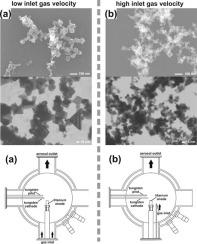Advanced Powder Technology ( IF 5.2 ) Pub Date : 2020-09-06 , DOI: 10.1016/j.apt.2020.08.012 Qingqing Fu , David Kokalj , Dominic Stangier , Frank Einar Kruis , Wolfgang Tillmann

|
Arc discharge synthesis has industrial relevance due to its low cost and scale-up potential. The production of titanium nitride nanoparticles was achieved by direct current arc discharge in an atmospheric-pressured ambient composed of N2 and Ar. We systematically investigated the effect of the synthesis parameters, including quench gas velocity, quench gas composition, and applied arc current, on the particle quality, yield, and size. It is found that increasing quench gas velocity enables to produce particles with a primary size of 10–15 nm, while titanium nitride particles of 20–50 nm are produced at low quench gas velocity based on scanning electron microscope (SEM) analysis. X-ray diffraction (XRD) results indicated that titanium nitride particles produced at various nitrogen compositions are almost stoichiometric, while the crystallite size increases almost 20 nm when increasing nitrogen contents in the quench gas. Quench gas composition also has a significant impact on the arc voltage as well as particle production rate. When increasing the nitrogen concentration from 20% to 100%, the production rate can be enhanced by a factor of three. Besides, raising the applied arc current from 12 A to 50 A leads to a yield enhancement of factor 10. According to the Brunauer-Emmett-Teller (BET) measurement, the increase of applied arc current has a limited impact on primary particle size. The enhancement in particle production rate is mainly reflected by the larger agglomerate sizes and agglomerate number concentration. Additionally, based on experimental observations and previous studies, a mechanism is presented to explain the growth of deposits on the cathode tip.
中文翻译:

直流电弧放电气溶胶合成氮化钛纳米粒子
电弧放电合成因其低成本和规模化潜力而具有工业相关性。氮化钛纳米颗粒的生产是通过在由N 2组成的大气压环境下通过直流电弧放电实现的和Ar。我们系统地研究了合成参数(包括淬火气体速度,淬火气体组成和施加的电弧电流)对颗粒质量,产率和尺寸的影响。根据扫描电子显微镜(SEM)分析,发现增加的淬火气体速度能够产生初级尺寸为10–15 nm的颗粒,而在低的淬火气体速度下产生20–50 nm的氮化钛颗粒。X射线衍射(XRD)结果表明,在各种氮组成下产生的氮化钛颗粒几乎是化学计量的,而当淬火气体中的氮含量增加时,晶粒尺寸增加近20nm。淬火气体的组成也对电弧电压以及颗粒产生速率具有重要影响。将氮气浓度从20%增加到100%时,生产率可以提高三倍。此外,将施加的电弧电流从12 A增加到50 A会使产率提高10倍。根据Brunauer-Emmett-Teller(BET)的测量,施加的电弧电流的增加对一次粒径的影响有限。颗粒生产率的提高主要反映在较大的附聚物尺寸和附聚物数量浓度上。此外,基于实验观察和先前的研究,提出了一种机制来解释阴极尖端上沉积物的生长。根据Brunauer-Emmett-Teller(BET)的测量,所施加电弧电流的增加对一次粒径的影响有限。颗粒生产率的提高主要反映在较大的附聚物尺寸和附聚物数量浓度上。此外,基于实验观察和先前的研究,提出了一种机制来解释阴极尖端上沉积物的生长。根据Brunauer-Emmett-Teller(BET)的测量,所施加电弧电流的增加对一次粒径的影响有限。颗粒生产率的提高主要反映在较大的附聚物尺寸和附聚物数量浓度上。此外,基于实验观察和先前的研究,提出了一种机制来解释阴极尖端上沉积物的生长。



























 京公网安备 11010802027423号
京公网安备 11010802027423号